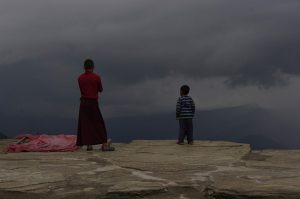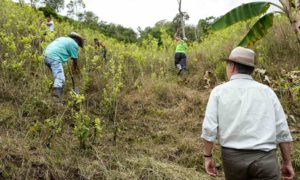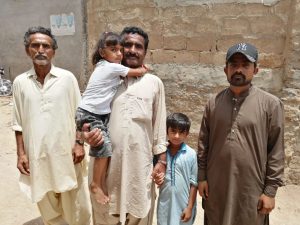On a Monday evening, Delowar Jahan’s modest shop was overflowing with fresh produce that arrived early in the day. In a middle-class Dhaka neighbourhood, this tiny outlet of a farmers’ collective does not have to compete with supermarkets and other grocery shops that are offering cheaper produce. Jahan’s shop has loyal customers who order and wait for days to get ‘naturally’ produced grains, vegetables, oilseeds and fish. “Use of non-organic fertilisers, pesticide, insecticide, and antibiotics are out of control in Bangladeshi agriculture and particularly in fish-farming, so families who are health-conscious always try to buy safe products,” said Jahan, who leads the farmers’ collective called “Prakritik Krishi” (Natural Farming).
In recent years families across Bangladesh who can afford ‘deshi’ or indigenous fish that are wild-caught or organically farmed, avoid “Chash er Maach”— fish produced through intensive monoculture. Farmed fish has recently gained a reputation for being a health hazard. Headlines such as ‘poison in fish’ are easily found in mainstream media outlets.
Every once in a while, when new information about the uncontrolled use of non-organic fertilisers in fish-farming, or the heavy presence of antibiotics and harmful chemicals in fish available in the markets make rounds in social media, it becomes a national outrage. The level of outrage has even forced the Bangladesh Fisheries Research Institute — the main state-run agency for fisheries research — to run media campaigns to assure frightened consumers. One such campaign was solely to claim that Tilapia is safe to eat.
Fish-farming that ‘decimates everything else’
Intensive fish-farming was introduced in Bangladesh in the early 1980s through state-run agricultural extension projects supported by the UN’s Food and Agriculture Organisation (FAO). It was popularised using special programmes aired by state-run television and radio stations.
![A drinking-water distribution station for villagers in a south-western district of Bangladesh, where development of shrimp and fish farming increased water salinity and decimated almost all freshwater sources [image by: Mohammad Arju]](https://dialogue.earth/content/uploads/2019/07/TTP_IMG4221-1.jpg)
During the same period, the amount of naturally harvested fish has gone up just two and a half times, from 648,468 metric tonnes in 1986 to 1,674,770 metric tonnes in 2016. In a coastal country with a multitude of rivers, vast wetlands and floodplains, this discrepancy seems especially striking. Part of the reason is that the agricultural practices promoted by academics, research institutions and state-run projects have focussed on narrow parameters.
Describing his many encounters across the country with fish-farming as prescribed by public-agencies, Jahan said, “It decimates everything else — every other organic life-forms in our water bodies, and I think it has played a vital role in the collapse of our freshwater aquatic systems. If you open any manual by any university, [those produced by the] Department of Fisheries, or even high school textbooks, the instructions are very clear how to do that.”
In a 2017 study titled “Impact of Aquaculture and Contemporary environmental issues in Bangladesh”, Mehady Islam and Rumana Yasmin concluded, “particularly monoculture of Tilapia and other carp species was found as highly threating to local aquatic health and food systems”. The study showed that “leftover feed, faeces, antibiotics, hormones” and “escape of these hybrids” from Tilapia farms were causing real harm.
Speaking to thethirdpole.net at the Aquatic Bio-resource Laboratory, a Fisheries and Aquaculture Faculty at the Sher-e-Bangla Agricultural University in Dhaka, Kazi Ahsan Habib said that intensive fish-farming is part of a bigger problem in Bangladesh. “Uncontrolled and extensive use of non-organic nutrients is not just limited to aquaculture; our total industrialised agriculture is being run on such practices.” Habib said that the main problem was that “in many cases we neglected to sustainably manage inland capture fisheries.”
He added, “Now, it is not only a threat to the land, recently it’s been reported that because of the eutrophication process there is a vast ‘dead zone’ in the Bay of Bengal. To realise the potentials of a blue economy in the Bay of Bengal, we have to stop these agricultural run-off sources on land in Bangladesh and India. Otherwise, wild-caught marine fisheries will also decline very rapidly.”
It starts with “pond preparation and fertilising”
The Bangladesh Fisheries Research Institute (BFRI) partially acknowledged the problem in a report published in 2013. Titled “Impact of Aquaculture Drugs and Chemicals on Aquatic Ecology and Productivity”, the countrywide study noted the high use of non-organic chemicals was having a major impact on health and aquaculture.
In intensive fish-farming, before releasing the fishlings bought from hatcheries, farmers are instructed to prepare the pond by drying it out and eliminate any other living species or organism that naturally exist. After drying the pond bottom and using pesticides and insecticides, the farmers let the water re-enter and fertilise the ponds. Though the fertilisation can be done using organic nutrients, the BFRI study found that non-organic fertilisers like urea, Triple Super Phosphate (TSP) and Muriate of Potash (MOP) are widely used.
A pond prepared for fish farming will usually have fertilised water with a thick green cover, and give off an unpleasant odour. Ponds in Bangladesh were traditionally used as a drinking water source, and for bathing, washing, food preparation and other domestic uses. Women in rural areas still spend a major part of their day at ponds — using water that is now loaded with fertilisers, pesticides and antibiotics.
Emissions, import bills, and pollution
Production and sale of non-organic fertilisers are heavily subsidized in Bangladesh. Traditionally, agencies such as Department of Agricultural Extension and Department of Fisheries assess the demand of non-organic fertilisers in advance to make sure that supply by the state-run factories will be enough.
The International Fertiliser Association estimates that in 1990 the total consumption of fertilisers in Bangladesh was 931,000 tonnes which increased to reach 2,305,000 tons in 2016. Almost 70% of this is imported. As the country is struggling to supply natural gas to urea factories from domestic sources, the import of natural gas and fuel-oils is increasing very rapidly. The FAO estimates that emissions from agriculture have increased by almost 25% since 1990; 9.8% of the total emissions come from non-organic fertilisers.
Another crisis is triggered every dry season when different public agencies fight over who gets to use the natural gas supply: irrigation pumps in paddy fields or urea fertiliser factories. The energy sector in the country is almost totally dependent on non-renewable fossil fuel sources such as fuel-oils and natural gas, with only 1.5% of power grid supply coming from renewable sources.
Urea is the most used non-organic fertiliser in the country. The 2013 BFRI study also mentions that all urea fertiliser factories discharge untreated effluents to rivers. It identified at least four fertiliser factories in Bangladesh discharging a “huge” amount of untreated effluents, polluting whole basin areas, with disastrous results for natural fish production in those rivers.
Bangladesh has a crucial problem in this regard. Habib explained, “As an active delta with vast floodplains in our river basin areas, aquaculture ponds are either always – or at least seasonally – connected to natural water bodies. And the most worrying thing here is that synthetic nutrients, pesticides, insecticides, antibiotics, all others drugs and chemicals from ponds and hatcheries get to easily reach the aquatic systems. We just can’t allow the degradation of our freshwater system to continue.”
Tomorrow: In Bangladesh, more fish, but persistent malnutrition
![<p>Tilapia in an intensive monoculture pond in an eastern Bangladesh wetland. Conversion of wetlands and homestead ponds into intensive fish-farms is responsible for the loss of fisheries biodiversity [image by: Mohammad Arju]</p>](https://dialogue.earth/content/uploads/2019/07/TTP_DSC00311-1.jpg)




![The Amarnath cave and the market near the shrine. Besides the market, there is a large langar (food canteen) which provides food to the pilgrims during the day; and dinner for those who stay at the site for the night [image by: Athar Parvaiz]](https://dialogue.earth/content/uploads/2019/07/1-1-300x199.jpg)

![Upendra Prasad Singh, the Union Secretary for Water Resources [image courtesy: Jal Shakti Ministry]](https://dialogue.earth/content/uploads/2019/07/UP_Singh_Photo_Jal-Shakti-Ministry-1-300x164.jpg)
